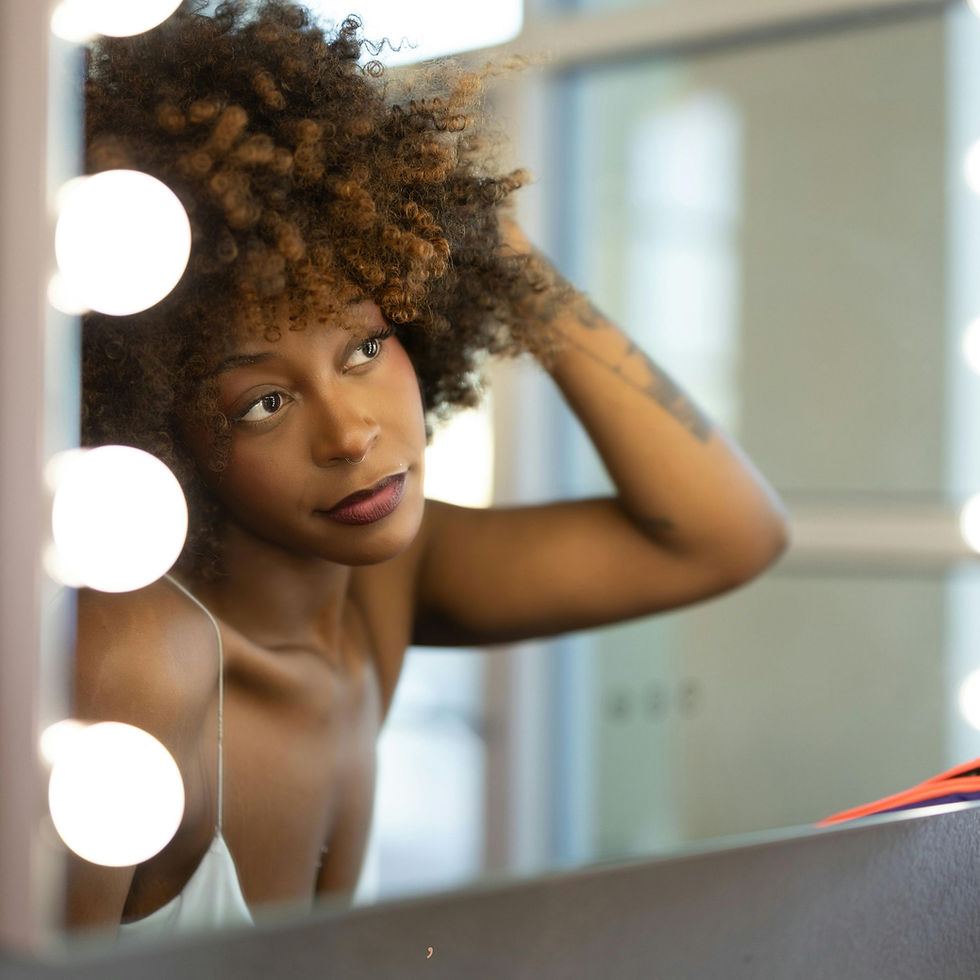Bringing Color to Life: The Art and Science of Natural Hair Colorization
- Stacy Ngina
- Sep 2, 2024
- 5 min read

Hi lovelies!!
Coloring natural hair has long been a way to express individuality, creativity, and style. However, the journey to achieving vibrant, healthy, and long-lasting color on natural hair requires a deep understanding of the art and science behind it. The colorization of natural hair is more than just applying dye; it's a meticulous process that balances the structure and needs of natural hair with the desired outcome. In this blog, we'll explore the techniques, challenges, and best practices for coloring natural hair while maintaining its health and vibrancy.
The Unique Structure of Natural Hair
Before diving into the colorization process, it’s essential to understand the unique structure of natural hair. Natural hair, often characterized by its curl pattern, density, and porosity, requires a different approach than straight or chemically treated hair.
1. Curl Pattern: The curl pattern of natural hair can range from loose waves to tight coils. These curls create more surface area and make it challenging for color to penetrate evenly. Additionally, the bends and twists of curls can cause hair to be more prone to dryness, which can affect the color's longevity and vibrancy.
2. Porosity: Natural hair tends to have varying levels of porosity, which refers to how well the hair absorbs and retains moisture. Highly porous hair absorbs color quickly but may not hold onto it for long, leading to faster fading. Conversely, low-porosity hair may take longer to absorb color, requiring more time and careful application.
3. Density and Thickness: Natural hair is often denser and thicker, meaning more product is needed to achieve full coverage. This also means that each strand must be thoroughly saturated with color to ensure an even and consistent result.
The Science of Hair Color
Coloring hair involves a series of chemical reactions that alter the hair's structure to deposit or remove color. Understanding these processes helps in choosing the right products and techniques for natural hair.
1. Permanent vs. Semi-Permanent Color: Permanent hair color opens the hair cuticle and deposits color into the cortex, the innermost layer of the hair shaft. This process often involves ammonia and peroxide, which can be harsh on natural hair if not used carefully. Semi-permanent color, on the other hand, coats the hair shaft without altering the structure, making it a gentler option for those concerned about hair health.
2. The Role of Developer: Developers, usually containing hydrogen peroxide, are essential in the colorization process. They help lift the hair's natural color, allowing the new shade to take hold. The strength of the developer (measured in volume) determines how much lifting occurs. For natural hair, lower-volume developers are often recommended to minimize damage.
3. Understanding Undertones: Natural hair has underlying pigments that can affect the final color result. For example, dark hair typically has red or orange undertones that can influence the outcome when lightened. A thorough understanding of these undertones is crucial for achieving the desired shade and avoiding unwanted brassiness.
Techniques for Coloring Natural Hair
Coloring natural hair requires specialized techniques to ensure even application, vibrant results, and minimal damage. Here are some key approaches:
1. Pre-Treatment and Preparation: Before applying color, it’s important to prepare the hair. This can include deep conditioning treatments to strengthen the hair and reduce the risk of damage. Clarifying shampoos may also be used to remove any product buildup, ensuring the color can penetrate evenly.
2. Sectioning for Precision: Natural hair's density and curl pattern make sectioning essential for even color application. Dividing the hair into small, manageable sections ensures that every strand is adequately covered. This is especially important for achieving uniform color on thicker, coarser hair types.
3. Application Techniques: The way color is applied can significantly impact the final result. For natural hair, a brush-and-bowl method is often recommended to ensure precise and thorough application. Using the hands to work the color through the hair can also help ensure even saturation.
4. Heat and Processing Time: Natural hair often benefits from added heat during the colorization process. Heat opens the hair cuticle, allowing the color to penetrate more deeply. However, the processing time must be carefully monitored to avoid over-processing, which can lead to dryness and breakage.
5. Post-Color Care: After the color is applied, it’s crucial to rinse the hair thoroughly and follow up with a deep conditioning treatment. This helps to seal the cuticle, lock in moisture, and preserve the vibrancy of the color. Using color-safe shampoos and conditioners, as well as regular protein treatments, can extend the life of the color and keep the hair healthy.
Challenges of Coloring Natural Hair
While the results of coloring natural hair can be stunning, the process is not without its challenges. Understanding these challenges can help in achieving the best possible outcome.
1. Color Fading: Natural hair tends to fade faster than chemically treated hair due to its porosity and curl pattern. To combat fading, it’s important to use sulfate-free shampoos, avoid excessive heat styling, and protect the hair from sun exposure.
2. Damage and Dryness: The chemical processes involved in coloring can strip natural hair of moisture, leading to dryness and potential damage. To minimize this, it’s crucial to maintain a consistent moisturizing routine, including deep conditioning treatments and the use of leave-in conditioners.
3. Uneven Color: Achieving even color on natural hair can be tricky due to its texture and density. Uneven application or insufficient product can result in patchy or inconsistent color. To avoid this, ensure that the hair is thoroughly saturated and that sections are small enough to allow for precise application.
4. Allergic Reactions: As with any chemical treatment, there is a risk of allergic reactions when coloring hair. Performing a patch test before applying color to the entire head is essential, especially for those with sensitive scalps or allergies.
Best Practices for Healthy, Vibrant Color
To achieve and maintain healthy, vibrant color on natural hair, it’s important to follow best practices both during and after the colorization process.
1. Choose the Right Products: Invest in high-quality hair color and products specifically formulated for natural hair. These products are often free from harsh chemicals and contain ingredients that help to nourish and protect the hair.
2. Regular Maintenance: Maintaining colored natural hair requires regular touch-ups and treatments. This includes root touch-ups every 4-6 weeks and regular deep conditioning treatments to keep the hair healthy and hydrated.
3. Protective Styles: Wearing protective styles, such as braids, twists, or updos, can help to minimize damage and preserve the color. These styles reduce manipulation and exposure to environmental stressors, helping to maintain the health and vibrancy of the hair.
4. Consult a Professional: While DIY hair color can be tempting, consulting a professional stylist who specializes in natural hair can make a significant difference in the outcome. A professional can assess the hair’s condition, recommend the best products and techniques, and ensure that the color is applied safely and effectively.
Embracing the Journey
Coloring natural hair is a journey that requires patience, care, and a willingness to experiment. Whether you’re going for a bold, vibrant shade or a subtle, natural hue, the key is to embrace the process and take the necessary steps to protect and nourish your hair. With the right approach, you can bring your natural hair color to life in a way that reflects your unique style and personality, all while keeping your hair healthy and strong.
In conclusion, the art and science of natural hair colorization are deeply intertwined, requiring a careful balance of creativity and technical knowledge. By understanding the unique structure of natural hair, the chemical processes involved in coloring, and the best practices for application and care, you can achieve stunning, long-lasting color that enhances your natural beauty. So, whether you’re a seasoned color enthusiast or a newcomer to the world of hair dye, remember that the journey to vibrant, healthy color is one worth taking—and with the right tools and knowledge, it’s one that can yield truly beautiful results.





Comments